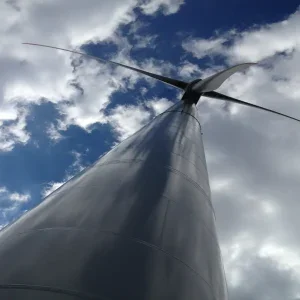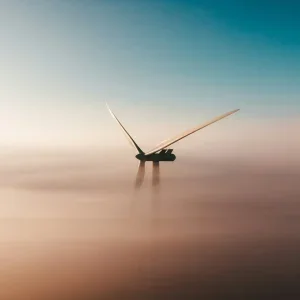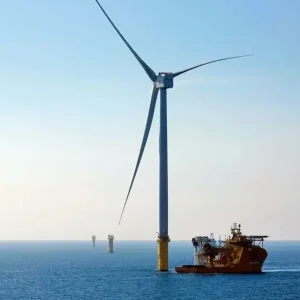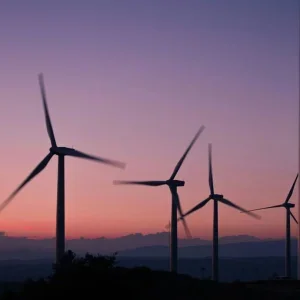Siemens made history when it unveiled the world’s largest wind turbine blades in 2012. Installed at a test centre in Østerild, Denmark, the prototype units measured 75m (246ft) from tip to tip, roughly the same as the wingspan of an Airbus A380.
The turbine itself measures 179m from top to bottom and can generate 6MW. This makes them 15 times the size of the firm’s first models, which were installed in the 1980s, with power production increasing a thousandfold.
This trend towards larger turbines shows no sign of abating. After all, the longer the blade, the more power can be generated, and because the relationship is exponential, rather than linear (with output increasing steeply as extra metres are added) longer units are also more efficient.
If offshore wind energy is to meet the electricity needs of the future, we are likely to see an increasing number of super-sized turbines. In fact, Siemens’ record is already about to be broken by a 100m model from UK-based Blade Dynamics. Funded by the Energy Technologies Institute (ETI)’s Very Long Blade project, the D100 is due to begin prototype testing in 2015 and will ultimately be installed on turbines generating up to 10MW.
Longer means cheaper
"The ETI’s vision is to support the development of next-generation blade technology because improved rotor performance is fundamental to achieving the goal of reducing the cost of offshore wind energy," said Andrew Scott, programme manager for offshore wind at the ETI.
In the context of this ongoing ‘arms race’, it might seem that the task is simply to scale up existing designs. However, doing so would be not just be inadvisable, but downright risky. As blades grow longer, they also get heavier, and adding weight inevitably means increasing cost.
Aside from the additional material needed, the blades become harder to ship and install, and require a stronger support structure. If you’re aiming to create an economical wind turbine, bulky blades will defeat that very purpose.
For Dr Povl Brøndsted, professor at the Composites and Material Mechanics section at the Technical University of Denmark, optimising blade weight is a core concern.
"When you add weight to a blade, you add weight to the whole installation, and of course, if you have a steel rod with 400t on top, then it’s important to reduce the weight as much as possible," he says. "By making the blades lighter, we save material, and therefore costs."
Brøndsted has worked with wind turbine blade materials for 40 years. Today, he is in charge of the university’s creative test lab for creating and certifying turbine blades, glass and carbon fibres and composite engineering, as well as performing consultancy work for blade manufacturers.
He feels that today’s blade designers need to start by looking at their basic building blocks. As blades get longer, they need to get stronger, as any flaws in material choice will be magnified.
"You need to be sure of the materials you’re using and be sure you have a good quality and uniform manufacturing process, because every mistake is a high price to pay if these big blades fail in production," he says.
While the vast majority of today’s blade designers still use glass-fibre composites (Brøndsted estimates 98%), certain manufacturers are exploring the possibility of switching over to carbon fibres. Despite costing more up front, these are significantly lighter and stiffer, and may therefore prove more economical overall. This explains the recent towards retrofitting turbines with carbon-based blades, which can be made longer and more powerful without adding weight.
Of course, new material composites are apt to bring new processing challenges, and it’s vitally important to ensure that carbon composites are defect-free. Misaligned fibres, for instance, can significantly reduce strength.
There is also the issue of compatibility between fibre and resin. Brøndsted firmly believes that more collaboration must be instigated between all the parties involved if the industry is to benefit from any major improvements in material design.
"If the manufacturers of fibre, the resin and the blade formed a sort of consortium, that would really enable us to improve the performance of the material itself," he opines. "I don’t think they should be so secretive, withholding information about their materials. Of course, they have their own manufacturing patterns and secrets, but working together has achieved some very good results."
Structural problem
Aside from material choice, designers also need to think about their overall structure, specifically, how to create maximally aerodynamic units. Through focusing on both sides of the equation – macro and micro – they are likely to enhance performance and reduce weight.
Somewhat paradoxically, tomorrow’s most predictable and dependable turbines may require the most radical design approaches. Siemens, for instance, is using a proprietary process called QuantumBlade to manufacture its 75m models.
Through using special lightweight materials – glass-fibre-reinforced epoxy resin and balsa wood – the blade is 20% lighter than a conventional design. This has a knock-on effect for the nacelles, towers and foundations, which don’t need to be so robust.
"This weight reduction is achieved by using specially designed blade profiles that are also shaped in a way that delivers maximum rotor performance at a range of different wind speeds," said the company in a release.
Blade Dynamics is taking a different tack. Rather than using a glass-fibre composite, the company has opted for a carbon-fibre design around 40% lighter than would be expected. These blades are also notable from a structural point of view. Whereas Siemens uses a process called IntegralBlade to mould each unit as a single, seamless entity, Blade Dynamics splices together smaller sections. The product is then finished off with a high-performance tip and a corrugated root configuration.
The advantages here are clear. Extra-long blades bring serious logistical challenges, not least the difficulties associated with delivering them. It has been speculated that, in future, the plants for large offshore turbines may need to be located right near the wind farm on the shore to eliminate transportation issues. A modular design is far easier in this regard, allowing manufacturers to deal with smaller, more manageable sections that are easily policed in terms of quality control.
So far, the principal difficulty with modular units has been strength related, in that bolting sections together creates stress points that weaken the blade. While Blade Dynamics’ process is non-mechanical, creating a robust, high-performance single piece, many other designers have struggled with structural integrity.
"I think we will start to see more modular constructions of blades; instead of building up one blade in one shot, designers will make it up of substructures, and then join the substructures," says Brøndsted. "Sub-components and modular construction will be a big challenge."
Damage limitation
Designers will also need a better understanding of their material choices and the underlying reasons for any failures. Given that blades are typically intended to last for 25-30 years, a material scientist might look at a 20-year-old blade and ask what kind of wear and tear was occurring. Through gaining insight into these damage mechanisms, scientists can better understand what constitutes a strong design.
"I am looking at optimising the fibre architecture, and also how to reduce internal stressors introduced by the manufacturing, because we have found they lead to basic damage in the blades," says Brøndsted. "How do we manufacture, how do we solidify, how do we cure the resin itself, what sizing and temperature are we using?"
As Siemens installs its 6MW turbines commercially, and blade design reaches the next stage of its development, it is clear that extra-large turbines are going nowhere in the years to come. With ambitious renewable energy targets across the globe, the industry is under pressure to generate the maximum amount of power at minimal costs. Blades must get longer and lighter, that is certain; the real question is how. This is a technical challenge that sits at the cutting edge of material science.






